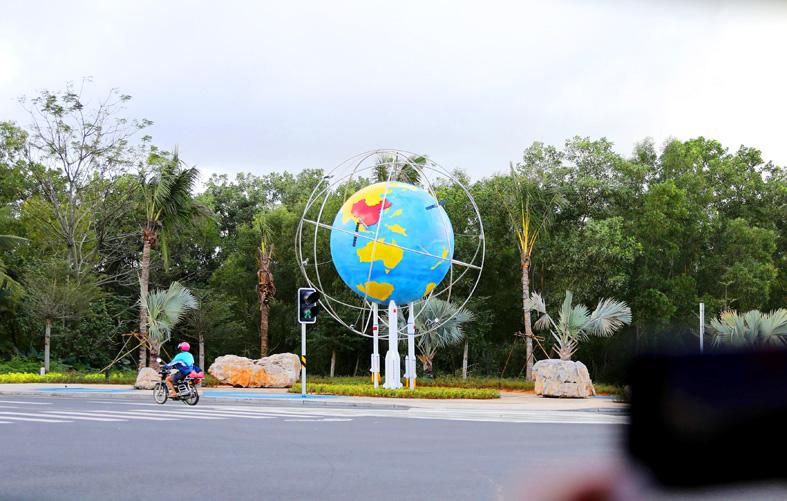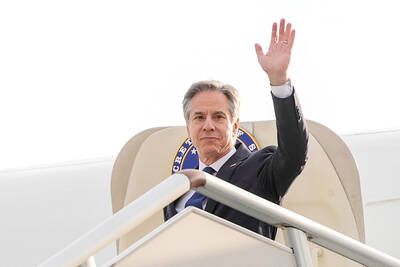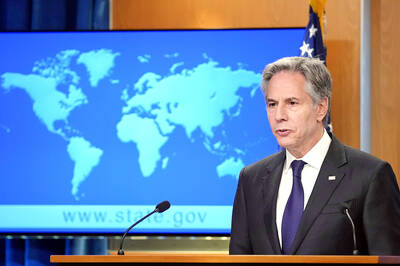China plans to launch an uncrewed spacecraft to the moon this week to bring back lunar rocks in the first attempt by any nation to retrieve samples from Earth’s natural satellite since the 1970s.
The Chang’e 5 probe, named after the ancient Chinese goddess of the moon, would seek to collect material that could help scientists understand the moon’s origins and formation.
The mission would test China’s ability to remotely acquire samples from space, ahead of more complex missions.

Photo: Reuters
If successful, the mission will make China only the third country to have retrieved lunar samples, following the US and the Soviet Union decades ago.
Since the Soviet Union crash-landed the Luna 2 on the moon in 1959, the first human-made object to reach another celestial body, a handful of other countries, including Japan and India, have launched moon missions.
In the Apollo program, which first put people on the moon, the US landed 12 astronauts over six flights from 1969 to 1972, bringing back 382kg of rocks and soil.
The Soviet Union deployed three successful robotic sample return missions in the 1970s. The last, the Luna 24, retrieved 170.1 grams of samples in 1976 from Mare Crisium, or the “Sea of Crises.”
China’s probe, scheduled to launch in coming days, would attempt to collect 2kg of samples in a previously unvisited area in a massive lava plain known as Oceanus Procellarum, or “Ocean of Storms.”
“The Apollo-Luna sample zone of the moon, while critical to our understanding, was undertaken in an area that comprises far less than half the lunar surface,” said James Head, a planetary scientist at Brown University.
Subsequent data from orbital remote sensing missions have shown a wider diversity of rock types, mineralogies and ages than represented in the Apollo-Luna sample collections, he said.
“Lunar scientists have been advocating for robotic sample return missions to these many different critical areas in order to address a host of fundamental questions remaining from earlier exploration,” Head said.
The Chang’e 5 mission might help answer questions such as how long the moon remained volcanically active in its interior and when its magnetic field — key to protecting any form of life from the sun’s radiation — dissipated.
Once in the moon’s orbit, the probe would deploy a pair of vehicles to the surface: A lander would drill into the ground, and then transfer its soil and rock samples to an ascender that would lift off and dock with an orbiting module.
If this is successful, the samples would be transferred to a capsule that would return them to Earth.
China made its first lunar landing in 2013. In January last year, the Chang’e 4 probe touched down on the far side of the moon, the first by any nation’s space probe.
Within the next decade, China plans to establish a robotic base station to conduct uncrewed exploration in the south polar region.
It is to be developed through the Chang’e 6, 7 and 8 missions through the 2020s and expanded through the 2030s ahead of crewed landings.
China plans to retrieve samples from Mars by 2030.
In July, China launched an uncrewed probe to Mars in its first independent mission to another planet.

‘IN A DIFFERENT PLACE’: The envoy first visited Shanghai, where he attended a Chinese basketball playoff match, and is to meet top officials in Beijing tomorrow US Secretary of State Antony Blinken yesterday arrived in China on his second visit in a year as the US ramps up pressure on its rival over its support for Russia while also seeking to manage tensions with Beijing. The US diplomat tomorrow is to meet China’s top brass in Beijing, where he is also expected to plead for restraint as Taiwan inaugurates president-elect William Lai (賴清德), and to raise US concerns on Chinese trade practices. However, Blinken is also seeking to stabilize ties, with tensions between the world’s two largest economies easing since his previous visit in June last year. At the
Nearly half of China’s major cities are suffering “moderate to severe” levels of subsidence, putting millions of people at risk of flooding, especially as sea levels rise, according to a study of nationwide satellite data released yesterday. The authors of the paper, published by the journal Science, found that 45 percent of China’s urban land was sinking faster than 3mm per year, with 16 percent at more than 10mm per year, driven not only by declining water tables, but also the sheer weight of the built environment. With China’s urban population already in excess of 900 million people, “even a small portion

UNSETTLING IMAGES: The scene took place in front of TV crews covering the Trump trial, with a CNN anchor calling it an ‘emotional and unbelievably disturbing moment’ A man who doused himself in an accelerant and set himself on fire outside the courthouse where former US president Donald Trump is on trial has died, police said yesterday. The New York City Police Department (NYPD) said the man was declared dead by staff at an area hospital. The man was in Collect Pond Park at about 1:30pm on Friday when he took out pamphlets espousing conspiracy theories, tossed them around, then doused himself in an accelerant and set himself on fire, officials and witnesses said. A large number of police officers were nearby when it happened. Some officers and bystanders rushed

Beijing is continuing to commit genocide and crimes against humanity against Uyghurs and other Muslim minorities in its western Xinjiang province, U.S. Secretary of State Antony Blinken said in a report published on Monday, ahead of his planned visit to China this week. The State Department’s annual human rights report, which documents abuses recorded all over the world during the previous calendar year, repeated language from previous years on the treatment of Muslims in Xinjiang, but the publication raises the issue ahead of delicate talks, including on the war in Ukraine and global trade, between the top U.S. diplomat and Chinese